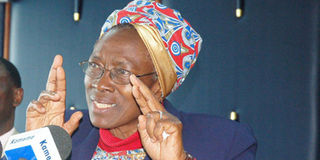Use the sun to kill germs in water

Prof Miriam Were made her presentation on the fourth day of the global health conference at Kenyatta International Conference Centre, Nairobi, last Thursday. Photo/FILE
A bottle of water placed on a piece of shiny roofing iron sheet may not look like something that would prevent disease, but according to a leading Kenyan scientist, it is a simple, yet effective, way to keep diarrhoea at bay.
What of a book with a record of one’s health from birth, and the tests carried out on one and the myriad pricks and injections one has had up to the age of five or even 20 years?
According to Prof Miriam Were, an award-winning scientist and National Aids Control Council chairperson, the adoption of these apparently simple but tested methods could be a crucial factor in the fight against child deaths.
Expensive ways
Prof Were bubbles with enthusiasm when she speaks about the methods she says could be used before sophisticated and expensive ways are available to the millions of poor people in black Africa.
She says that, for instance, the bottle-in-the-sun method is easy to adopt and cheap to implement, meaning that the millions of Nairobi slum dwellers without access to clean water, or rural people who do not have piped water, could benefit greatly.
The solar water disinfection uses the sun’s ultra-violet rays to kill germs in drinking water. The water is put in a plastic bottle and then in the sun for at least six hours. The method has been proved to kill E. coli, a bacterium that causes food poisoning, and one of the main causes of diarrhoea. It kills the bacterium when the water is exposed to the sun for a day when it is bright, or two days when it is cloudy.
“It requires a raised surface and a piece of shiny mabati (iron sheets) to work,” says Prof Were. “In the rural areas, the rack that is used for airing utensils may be used. We know piped water is ideal, but before it becomes available for all, this could work.”
The method has been proved to work in parts that lie between 35 degrees north and south of the equator, and Africa lies smack in the middle of the two latitudes. She made her presentation on the fourth day of the global health conference at Kenyatta International Conference Centre, Nairobi, last Thursday.
The conference that closed on Friday with the development of the Nairobi Call for Action, was attended by health professionals from all parts of the world. This was the first time it was being held in Africa, and Thursday was the “Africa Day” on which focus was on health promotion for the continent.
The Thursday morning session was dominated by calls for policy makers to focus on the “African experience” to get solutions to the myriad problems facing the continent. Prof Were’s second suggestion was the maternal and child health handbook, which is the result of studies in Nigeria that show that mothers could be better than hospitals in keeping the card containing the record of their children’s progress from the prenatal phase to five years.
In Japan, the method has been proved to work especially where a record of the mother’s pregnancy and the child’s medical history were placed in one book up to age five. It has been practised there for 60 years, and in some provinces, records are kept for up to 20 years. The book is then handed over to the bridegroom to prove that his bride is healthy.
Prof Were argued that the adoption of the process could help in strengthening medical care and push efforts to attain Millennium Development Goals four and five. Goal four involves reducing child mortality, while five is intended to improve maternal health.
From World Health Organisation records, black Africa currently lags behind other regions in attaining the goals set at the UN Millennium Summit in September 2000. “Kenya is unlikely to meet the MDG targets by 2015 at the current rates. A lot needs to be done,” said Public Health assistant minister James Gesami at the meeting.
Prof Were’s ideas received support from Zimbabwe’s health minister, Dr Henry Madzorera. “We can’t have breakthroughs in solving Africa’s health issues by depending on the experiences of the West,” he said. “The African experience in getting rid of poverty and disease is like the life of a butterfly, and we need our own efforts to break out of our cocoons.”
Prof Were’s ideas also resonated with a proposal by Dr Florence Muli-Musiime, the African Medical Research Foundation (Amref) deputy director. Dr Muli-Musiime said the adoption of simple and tested strategies should be explored before governments and NGOs indulge in endless research and the so-called new strategies. “There have been too many good pilot projects and success stories. Much is spent on funding new approaches rather than up-scaling simple, established and successful projects,” she noted.
She cited projects in South Africa in which traditional healers refer possible HIV patients to modern doctors, and the training of clinical officers in Southern Sudan to carry out simple operations that are usually the preserve of doctors.




